If there is one silver lining of this pandemic it’s that everyone now knows how to use their webcam. Having been on countless virtual work meetings, homeschooling sessions, and family gatherings, I can attest that there are large segments of the population that just three months ago didn’t know their laptop even had a camera who are now scheduling group calls, organizing virtual game nights, and having way too much fun with custom backgrounds.
In addition to being more comfortable in front of a webcam, people are also more accepting of lower quality videos in professional productions as they understand the limitations currently in place for filming and are seeing their work colleagues, friends, and family in the same quality. (My current favorite are the Progressive commercials!)
Who would have guessed that in 2020 grainy webcam video would be the breakthrough technology that connects everyone?
This change in behavior and attitude towards webcams gives those of us working in grassroots and issue advocacy new opportunities to capture voices and stories that would have otherwise gone unheard.
Having worked with a variety of clients over the past few months on these efforts, we’ve rounded up a few tips we’ve found useful when soliciting video stories and content:
- Schedule time to connect with your key advocates on video calls and make the call similar to using a videographer at an advocacy day. Have a list of questions to solicit stories and experiences from your advocates and record the calls using the tools in the video platforms. The video files can then be given to an editor to compile the best stories and then add music and appropriate b-roll to produce a compilation video with a call to action. Be sure to have your recording set to “speaker view” so you can get a full-screen recording to keep the focus on the advocate.
- Create a page where people can submit their stories about an issue and how it affects them. Be sure to have some sample stories from other people so there are examples to emulate. You’ll need to promote the page to get stories, but this “always-on” portal is an evergreen action you can use to keep your advocates energized and engaged. We’ve created pages like this for the American Heart Association and the Credit Union National Association, where our clients are collecting valuable stories via these sites.
- Utilize video to replace or complement text-heavy reports to engage viewers and video subjects in a different manner and format. This award-winning Sustainability Challenge video series we produced for the Business Roundtable accompanied their annual report to not just address this issue but show it.
- Record video calls to “interview” some of your key stakeholders then publish to social media, YouTube, and other online venues. This is a great way to share longer conversations about an issue with your target audience. In addition to talking to your advocates, this tactic can be used to highlight the work your organization is doing internally on the issue, for example by interviewing the head of government relations about the status of legislation or budget requests. We’ve worked with our clients at the American Association of Colleges of Osteopathic Medicine to produce an interview with a student advocacy leader as well as a video testimonial playlist for the National Center for Learning Disabilities, which you can see below:
The shutdowns caused by the coronavirus have stopped almost all in-person advocacy meetings and derailed lobby day events that were years in the making. Nevertheless, when one door closes, another one opens, and right now, the welcome mat has been laid out for advocacy professionals who want to collect stories from their grassroots advocates and use them to advance their missions. With home-bound audiences that are comfortable with webcams, there may not ever be a better time to build your story bank.
If you need any help you can reach out to us at Beekeeper Group. We’d love to work with you to uncover the stories and voices in your advocacy network.
